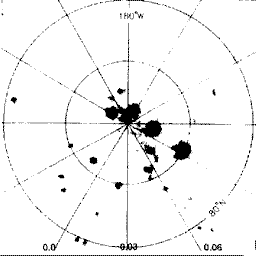 |
Science Frontiers ONLINE No. 95: Sep-Oct 1994 |
|
|
Snowballs in hell?
 Arecibo radar image of Mercury's morth pole showing several craters. |
Radar topographic studies of Mercury's polar regions, using the Jet Propulsion Laboratory's Goldstone antenna with the VLA (Very Large Array) plus the big Arecibo antenna in Puerto Rico, have been able to confirm that there are indeed craters in the polar regions of Mercury. These craters match up well with the radar reflectivity anomalies recorded earlier. So, it now seems likely that ice does exist on Mercury. And, since our moon also boasts permanently shadowed crater areas, ice probably survives there, too. This is good news for future lunar colonists.
But where could the ice on Mercury and the moon have come from? One source might have been the gases seeping out from the bodies' interiors. Also, cometary impacts could have added water vapor to the atmospheres. This would then have been deposited as frost in cold crater bottoms, just like the frost seen on winter window panes.
(Harmon, J.K., et al; "Radar Mapping of Mercury's Polar Anomalies," Nature, 369:213, 1994.)
Comment. But are comets really the water bearers the astonomers say they are? See the item under ASTRONOMY.